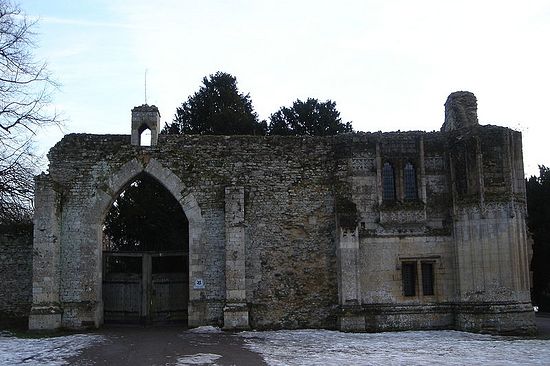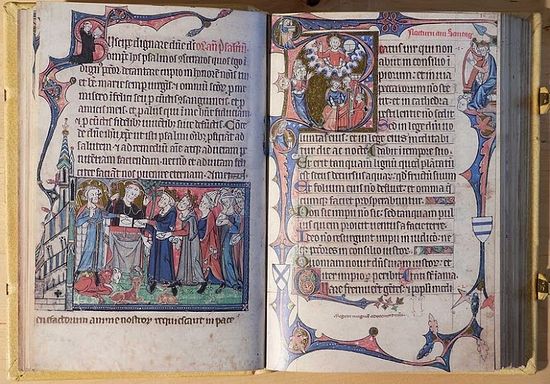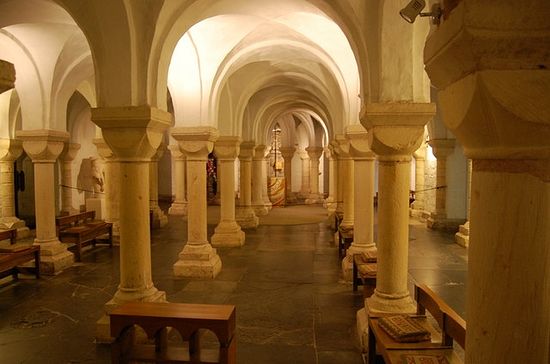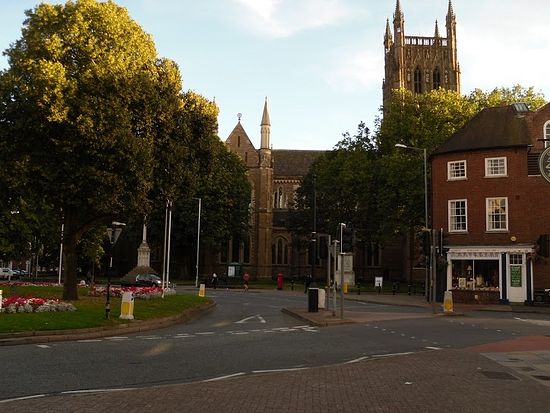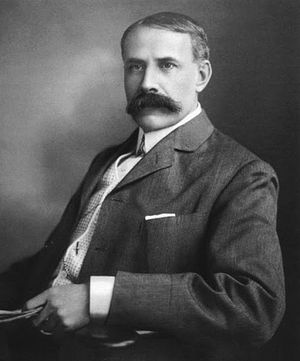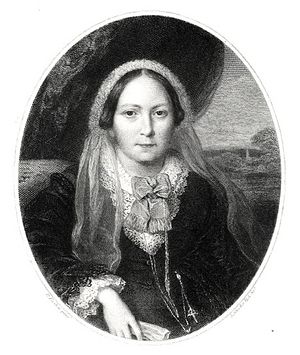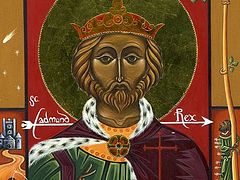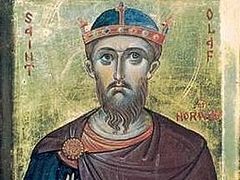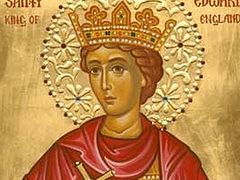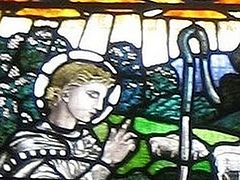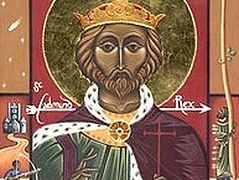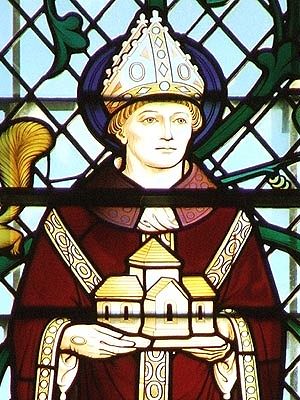 A stained glass image of St. Oswald of Worcester
A stained glass image of St. Oswald of Worcester As a boy and young man Oswald was raised by his uncle St. Oda and then studied at Winchester. At that time Church life, monasticism and discipline in the country had terribly declined after the devastations of the pagan Danes in the previous century. The saintly King Alfred the Great, who had saved the English State from destruction in the late ninth century, had only begun the long process of reviving the English Church by founding the monastery in Athelney and inviting Church figures to help him. For example, there was Werferth, a learned Bishop of Worcester from c.872 till c.915, a contemporary, friend and assistant of the Right-Believing King Alfred the Great at whose request he translated the Dialogues of St. Gregory the Dialogist from Latin into Old English.
St. Alfred’s work was continued by his tenth-century descendants, especially Kings Edward the Elder, Athelstan, St. Edgar the Peaceful and St. Edward the Martyr, and by the three holy English hierarchs: Sts. Dunstan of Canterbury, Ethelwold of Winchester and our saint—Oswald of Worcester, who was destined to be remembered in English Church history as a great archpastor and restorer. Oswald studied with married priests in Winchester for some years and it was there that he was eventually ordained a priest. But secular life was not for him, as Oswald had striven for a serious ascetic life since childhood.
Thus, in about 950 Oswald was tonsured and sent to the great monastery of Fleury in France (at Saint-Benoit-sur-Loire and which still exists). This monastery possessed the relics of St. Benedict of Nursia, “the father of Western monasticism”, and boasted the largest library in Western Europe. Oswald gained enormous spiritual experience and learned monastic skills in Fleury, staying there for about ten years. There he studied day and night, absorbing the Holy Scriptures and works of the Church Fathers. He even learned most of the services by heart. Once when the saint was serving the Divine Liturgy the people standing in the church saw an angel descending to him in the altar. On his deathbed, St. Oda, St. Oswald’s beloved uncle and mentor, sent messengers to him conveying his blessing to him to return to England and serve God and the people there. St. Oswald saw the will of God in it and, though it was a sorrow for him to leave Fleury, he came back to England.
On his return he learned that Oda had died shortly before. Oswald first wanted to go back to Fleury, but turned to his relative Oskytel in York who became his patron for some time. And it was Oskytel who introduced Oswald to the great archbishop-visionary and father of his people: Dunstan of Canterbury, who was undertaking a large restoration program in the English Church and needed like-minded people as his helpers. Dunstan came to love the young, mild, responsive and tactful Oswald and at once saw in spirit that his labors would yield bountiful fruit for the Church. So for the rest of his life Oswald dedicated his energies to reviving monasticism and spiritual life in the whole of England, in alliance with Sts. Dunstan and Ethelwold.
In 961 Dunstan consecrated Oswald Bishop of Worcester in western England, and this was to become a very large and prosperous diocese. This diocese still exists and it is already over 1330 years old. St. Oswald rebuilt the small St. Peter’s Cathedral Church at Worcester and the new cathedral was dedicated in honor of the Mother of God. The holy archpastor established in Worcester a large monastery and organized life there on the pattern of Fleury. It was a so-called “monastery-cathedral”; the tradition of building such ecclesiastical structures was characteristic of early England.
This monastery became one of the greatest in the English land. At that time in former English monasteries and cathedrals most of the clergy were married priests and there were almost no monks. Through the labors of “the three holy hierarchs of England” monasticism was very successfully reintroduced and spread all over England. By the end of that century there were thriving monastic communities for men and women throughout the country, despite the strong anti-monastic movement among part of the nobility (who murdered St. Edward the Martyr) and new Danish attacks.
But it was a difficult and gradual process in Worcester because it lacked monastic tradition. Oswald preached as best as he could inside his church and the townsfolk flocked to listen to the new preacher. Oswald also taught outside the church, often standing in an open space, and people’s hearts were drawn to him seeing his holiness and sincerity. Unlike St. Ethelwold, who out of zeal for the good of the Church often acted resolutely and quite sternly, in many cases physically expelling married priests from monasteries and replacing them with monks, St. Oswald acted very wisely and amicably. His approach was based primarily on love, temperance, patience and teaching. Like Dunstan, Oswald preferred to be slow and quiet rather than strict and quick. His very meek and amicable nature attracted the hearts of thousands of English people to him who loved him and gradually returned from their errors to the right path of genuine Christian life.
According to tradition, in Worcester Oswald first refused to demolish the church for married priests but built the new church for monks opposite it and allowed both communities to celebrate. Seeing the exemplary and pure life of the monks, hearing their magnificent choir singing (St. Oswald himself was a talented singer with a rare and beautiful voice, according to his contemporaries) and perfectly disciplined services, all the townsfolk started visiting them, and gradually deserted the church where married priests served, so they joined the monks or left and the old church was demolished. According to several records from that time, Oswald never forced any married clergy to leave, and until the end of his episcopacy there were married church workers and clergy in his monastery along with the monks.
In about 962, St. Oswald most probably rededicated the ancient monastery at St. Albans, the site of martyrdom of the first English martyr, St. Alban. At the same time he founded a new monastic community in Westbury-on-Trym near Bristol in Somerset, which was another great establishment (it first consisted of his twelve disciples). Early in the 970s, in alliance with the Right-Believing King Edgar the Peaceful, the lover of monks and supporter of monastic life in his kingdom, St. Oswald refounded (or restored) seven old monasteries in Western England. In the Severn valley these included Pershore and Evesham in Worcestershire (renowned centres of monastic life, holiness, and pilgrimage for centuries), and in Gloucestershire they most likely included Deerhurst, Winchcombe and Gloucester.
The holy archpastor gained so many pupils that he needed to open another new large community. So in 971 Oswald established a monastery outside his diocese at Ramsey in Cambridgeshire (it was then a peninsula with fens or marshes on three sides) and dedicated it to Our Lady, St. Benedict, and All Holy Virgins. The place offered everything that Oswald wanted for his monks: level land, rich soil, fresh water (the River Ouse flowed nearby), all kinds of fish and fowl, and solitude. This grew into a large and his most beloved monastery; in fact Oswald was its first abbot and spent much time in it. St. Oswald beautified and adorned the monastery church of Ramsey for many years, and some descriptions of the splendid church of his age still survive. Afterwards Ramsey developed into one of the wealthiest and one of most prominent medieval monasteries in England; some buildings and ruins of the former Ramsey Monastery are now used by a local college and the twelfth-century Church of St. Thomas Becket (built by the monastery as an infirmary or guesthouse) is still active.
All these labors finally led to the restoration of monastic life at Crowland in Lincolnshire: a great center on the site of the early eighth-century hermitage of St. Guthlac amid the marshes, who is recorded as “the English St. Antony the Great”. This great revival movement finally led to the restoration of monastic life in the north of England, though it was accomplished later, not in the lifetime of the three English holy hierarchs, because the Danish settlers’ influence in the north was still too strong at that time. Together with Dunstan and Ethelwold, Oswald worked on the preparation of the important document, Regularis Concordia, which was adopted and signed in 970. This document regulated monastic life and discipline in England.
In 972, Oswald was appointed Archbishop of York while retaining the post of Bishop of Worcester. This not very canonical measure was explained by the very weak monastic life in the north of England after the Danish invasions. In Yorkshire Oswald did all his best to revive monastic life, especially in Ripon where the monastery had been founded in the seventh century by the great missionary St. Wilfrid of York. In Ripon he may have collected portions of relics of local saints, including St. Wilfrid, and taken them to Worcester Cathedral for veneration; so, tradition holds that some relics of Wilfrid may be hidden inside this Cathedral to this day. An ascetic, visionary, encourager of monks and consoler of the people, St. Oswald (like his fellow archpastors Dunstan and Ethelwold) was an able advisor of the royal family for many years as well. Due to his close links with the royal house he managed to secure extensive lands for his monasteries.
Up to the end of his life Oswald remained an active preacher, energetic bishop, and builder of many churches. He often visited all his monasteries as a good shepherd. He promoted learning among his monks, inviting from Fleury preachers, mathematicians and astronomers. He himself wrote several treatises. Among other saints linked with St. Oswald we can mention St. Abbo, a learned monk of Fleury who was invited to Ramsey in the 980s for two years, either by Oswald (which is more likely) or else Dunstan, and there he taught. Significantly, while in England Abbo learned the story of the martyrdom of the Holy King Edmund of East Anglia and wrote his Life which survives to this day.
Another saint was Oswald’s kinsman Ednoth (feast: October 19/November 1). He studied at Worcester under St. Oswald and became a monk and eventually Abbot of Ramsey. He later founded St. Ives Monastery and Chatteris Convent in Cambridgeshire. About 1007 he became Bishop of Dorchester-on-Thames but in 1012 he was martyred by pagan Danes. His relics were kept at Ely. Sts. Oswald and Ednoth are depicted together in the fourteenth-century manuscript known as the “Ramsey Psalter”. There is, however, another, earlier illuminated “Ramsey Psalter”, most likely produced by Ramsey monks and personally belonging to St. Oswald; it is now preserved in the British Museum.
Late in 991, Oswald spent time at his beloved monastery of Ramsey where he kissed and blessed his monks for the last time. He felt that his end was near, so before his departure he said to the brethren, “May the Lord gather all of us in the Heavenly Kingdom.” He spent the winter in Worcester and on February 29,[1] 992 (that was a leap year), he served his last Liturgy. It was during Lent. Then, singing the Psalms, he washed the feet of twelve poor men, as was his daily custom during the Lenten fast. The saint of God reposed on the same day while kneeling and having just uttered the words: “Glory to the Father and to the Son and to the Holy Spirit!”
The news of the repose of the holy father and bishop spread to towns and villages very quickly. It was said that on that day traders left their shops, women stopped their weaving, and all hastened to him: orphans, widows, monks, clergy, strangers, peasants and paupers – all those whom he had taken care of in his lifetime. All wept in their grief. When his body was carried to the site of his burial in Worcester, a white dove soared over the procession. The hierarch was venerated and remembered for his holy life and learning, for mercifulness and generosity, for honesty and meekness, for hospitality and care for the poor. An author of his Life states that he was loved during his life and venerated after his death. Indeed, he was a rare humble and kind-hearted saint, with a pleasant appearance, melodious voice, open and attractive nature and many talents;[2] in spirit he was very close to such early English saints as Cuthbert, Aidan, Chad, John of Beverley, Cuthman and Swithin of Winchester.
In 1002 Oswald’s relics were solemnly laid in a new shrine. Finally his veneration became national. He was particularly commemorated in Worcester, York and Ramsey. In the second half of the eleventh century the Worcester Monastery-Cathedral (from that time known as St. Mary’s Priory) was rebuilt by Oswald’s great successor, Wulfstan of Worcester (1008-1095; the last native English bishop from the “old” Church who served after the Norman Conquest) and his relics for some time rested in the monastery crypt from then on. Throughout the centuries numerous miracles occurred at the relics of Sts. Oswald and Wulfstan (the latter is venerated as a saint by Roman Catholics) at Worcester Cathedral whose tombs were located near each other. King John Lackland was so impressed by the spirit of holiness at Worcester Monastery that he ordered that he be buried between these two saints at the Cathedral (it was due to this close royal connection that the Cathedral was not destroyed during the Reformation).
During the Reformation the shrines of both saints were demolished, and their relics, according to tradition, were buried under the floor near the altar of the Cathedral where they may rest to this day, waiting for the time when they are again revealed to faithful Christians.
***
Let us now talk about the Worcester Monastery Cathedral. The early English Cathedral in Worcester was built in 680 and dedicated to St. Peter. The third bishop of this diocese was St. Egwin who founded Evesham Abbey on the site of a miraculous apparition of Mary the Mother of God. From 957 to 959, St. Dunstan served as Bishop of Worcester before being raised to the rank of Primate of the English Church. St. Oswald, the most venerated saint of the beautiful, Roman-founded city of Worcester, was bishop here in 961-992. Since then the monastery in Worcester has been dedicated to the Mother of God. In 1040 Worcester was badly damaged by a Danish invasion but was rapidly restored. Under Bishop Wulfstan, construction of a large new Cathedral began in 1062.
In 1084 the building of the many-columned Cathedral crypt was begun by the Normans; it still exists in perfect condition and is regarded as one of the finest in the country. It has exhibitions devoted to the Cathedral’s early English past. Remarkably, it displays the boots, staff and part of the emblem of Santiago de Compostella of a fifteenth-century pilgrim whose remains were discovered under the floor of the Cathedral in 1986. The remains were examined by scientists from the University of York and it is now presumed that they belong to Robert Sutton, a wealthy Worcester dyer who loved pilgrimages.
After the Norman Conquest what is now the Catholic cathedral-priory grew and developed. The motto of its monks was: “No prayer without work, no work without prayer.” Worcester’s brethren were occupied by growing plants, various crafts, teaching, and scholarship. They received and always generously treated thousands of pilgrims, performed public and private services, and ministered to those in need. They fed and clothed the poor and the hungry, managed a hospital, and gave communion to prisoners. Many scholars were produced by Worcester. Among them we can mention Florence of Worcester (+1118), a monk and chronicler who took part in the compilation of the Chronicle of Chronicles in Latin, which related the history of the world from the Creation till 1140; John of Worcester (+1140), a devout monk and man of learning who completed this chronicle, which survives in five manuscripts; the antiquarian, prolific author and chronicler William of Worcester (c.1415-1482) who travelled extensively across the country.
This was not the only monastery in Worcester in the Middle Ages. In the medieval period there were also the Black (Dominican) Friars, Friars of the Sack, the Grey Friars (Franciscan Friars Minor; a part of the friary remains intact), the Penitent Sisters, the Trinitarians and probably other communities. What today is called the Commandery Museum in Worcester was originally the hospital and almshouses founded by St. Wulfstan in 1085. In its long history it served as a charitable home, a hospice for the dying, a hostel for pilgrims (founded by the Knights Hospitallers), and was even the headquarters of the Royalist Army during the Civil War.
Worcester is also famous for its ancient and very rich musical traditions. Among the great composers who were closely related to Worcester Cathedral let us mention Thomas Tomkins (1572-1656), a pupil of William Byrd, organist and madrigal-writer who composed a large amount of Church music; and the greatest composer in English history Sir Edward Elgar (1857-1934, a Roman Catholic). Both spent part of their lives in and near Worcester. (The birthplace of Elgar is in Lower Broadheath just outside the city). Elgar, who precisely in Worcester first performed his famous work, The Enigma Variations, is commemorated at the Cathedral on one of its stained glass windows and his monument stands in the city center close by. The Church music of both composers is often performed in the Cathedral.
Worcester is one of the three English cities in which since 1724 the annual festival of spiritual music called, “The Three Choirs Festival”, has been held (the other two cities are Gloucester and Hereford)—this is the oldest music festival in the world, and it is held in each of these cities alternately. Among celebrities buried at the cathedral are King John Lackland (1167-1216) and Prince Arthur Tudor (1486-1502—the elder brother of the future King Henry VIII who died at Ludlow Castle in Shropshire aged only 15 (who knows, maybe if Arthur, and not Henry, had succeeded to the throne, the bloody Reformation with all its consequences would have not happened)[3] and the Prime-Minister Stanley Baldwin (1867-1947).
Another eminent figure in Worcester was the prominent author and novelist Ellen Wood (1814-1887). She wrote under the pseudonym Mrs. Henry Wood and her novels, such as East Lynne, were translated into many languages. Her monument can be found in the Cathedral. A hero connected with Worcester is the Anglican priest, preacher and poet Geoffrey Studdert Kennedy (1883-1929, nicknamed “Woodbine Willie”) who served at the city’s St. Paul’s church. During the First World War he volunteered as a chaplain and, at permanent risk to his life, he courageously rescued, helped and consoled wounded and dying soldiers in no man’s land. He supported them spiritually and gave them woodbine cigarettes, hence his nickname. For his self-sacrificing work he was awarded the Military Cross (commemorated by some in the C of E on March 8).
In 1540 the Benedictine priory at Worcester was closed: though the church itself survived and has been used as Anglican Cathedral since then, some monastic buildings were destroyed or used for other purposes. In the seventeenth century the Cathedral was greatly damaged by the Republicans (it should be recalled that there were many Royalists in and around Worcester), and the famous Battle of Worcester took place in 1651, when Oliver Cromwell defeated the Scottish armies of the future Charles II. In the nineteenth century large-scale restoration work was carried out at the Cathedral, and Sir George Gilbert Scott contributed much to it. Restoration resumed in the 1980s.
Today this magnificent ancient Cathedral, standing on the banks of the River Severn and dedicated to Christ the Savior and the Most Holy Virgin, attracts thousands of pilgrims from around the world every year. The Cathedral is influenced by many architectural styles, from Norman to Perpendicular. Apart from the crypt, a true gem of the Cathedral is its circular chapter-house (early twelfth century; the only round chapter-house in England) that has survived in perfect condition from ancient times. In this room monks used to read a chapter of the rule of St. Benedict every day (hence its name) and settle everyday monastic affairs. Of the surviving former monastic buildings we can mention the refectory. The medieval central tower of the cathedral is fifty-two feet high and offers fantastic views of the city from its top. The peal of the Cathedral’s bells is one of the most beautiful in England, according to many.
The Cathedral is famous for its thirty-nine ancient misericords (ledges projecting from the underside of hinged seats in choir stalls which, when the seat is turned up, give support to someone standing nearby—they were used by monks during long services) with fine carvings depicting scenes from the Bible or folklore. The unique medieval former monastic library still survives in the Cathedral: some of the Abbey manuscripts are kept there, while the rest are in the British Library in London and in Oxford and Cambridge. From those kept at Worcester (most of them have been digitalized today) there are about 300 medieval documents from the tenth to the fifteenth centuries, 5,500 post-medieval books, about 20,000 archive documents from various epochs and a large music collection. There is a rich set of stained glass throughout the Cathedral depicting numerous saints, Bible characters and events, kings and writers.
On a more secular side, Worcester gained fame for glove-making, the special Worcester sauce, Worcester porcelain and for Berrow’s Worcester Journal which claims to be the oldest newspaper in the world still in circulation (it began in 1690). Worcester is a city with a particular atmosphere of peace and warmth, especially at the Cathedral with its homely feel so close to Orthodox hearts. We believe that it owes much of this spirit to the prayers of St. Oswald who blessed this place through his holy life and deeds.
Holy Hierarch Oswald of Worcester and York, pray to God for us!


